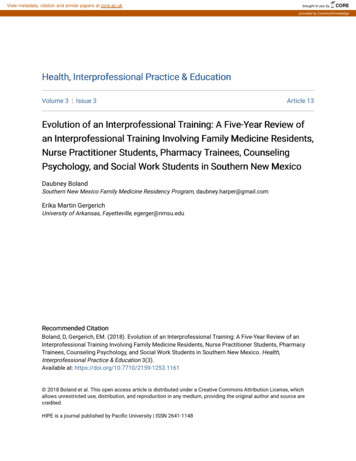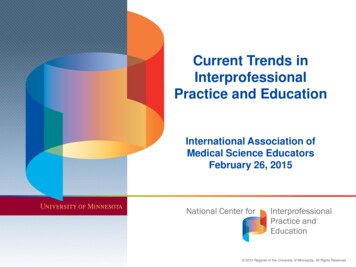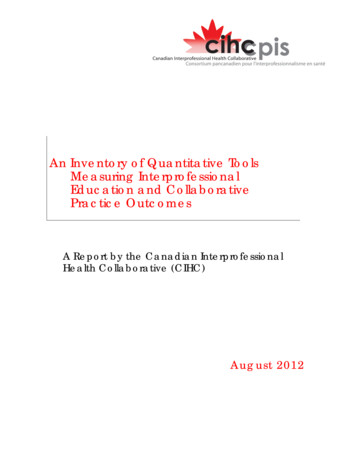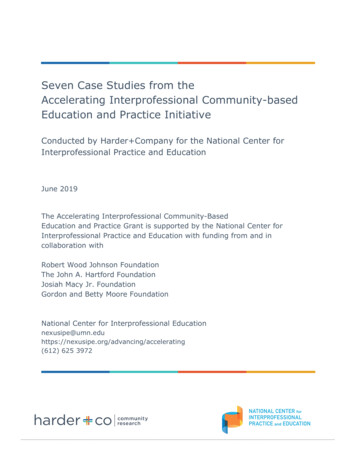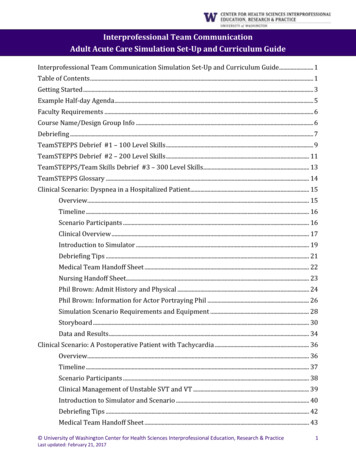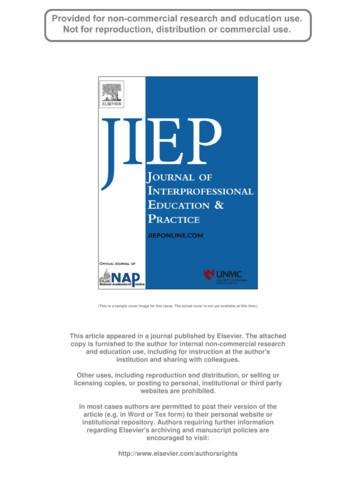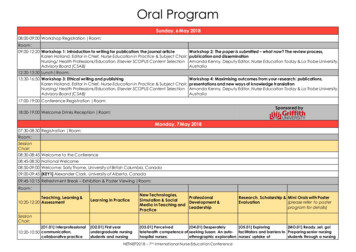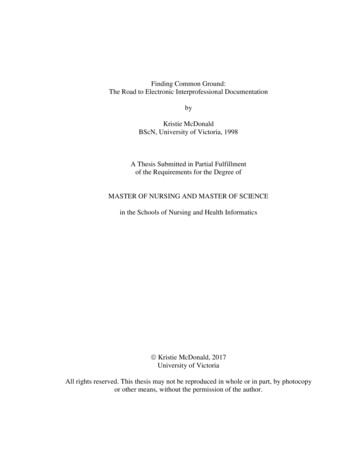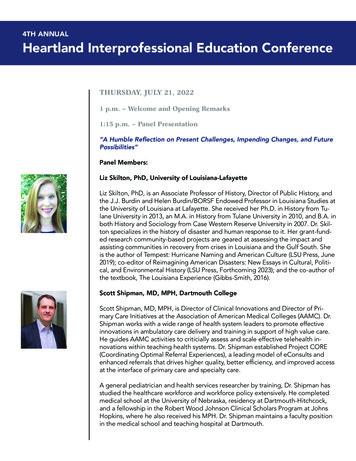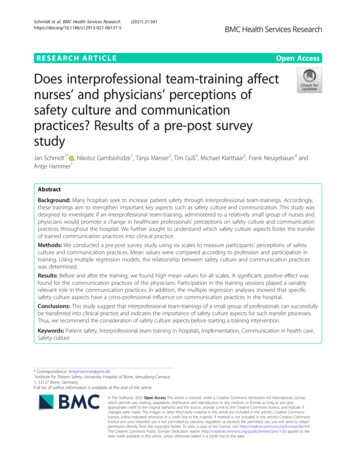
Transcription
Schmidt et al. BMC Health Services (2021) 21:341RESEARCH ARTICLEOpen AccessDoes interprofessional team-training affectnurses’ and physicians’ perceptions ofsafety culture and communicationpractices? Results of a pre-post surveystudyJan Schmidt1* , Nikoloz Gambashidze1, Tanja Manser2, Tim Güß3, Michael Klatthaar3, Frank Neugebauer4 andAntje Hammer1AbstractBackground: Many hospitals seek to increase patient safety through interprofessional team-trainings. Accordingly,these trainings aim to strengthen important key aspects such as safety culture and communication. This study wasdesigned to investigate if an interprofessional team-training, administered to a relatively small group of nurses andphysicians would promote a change in healthcare professionals’ perceptions on safety culture and communicationpractices throughout the hospital. We further sought to understand which safety culture aspects foster the transferof trained communication practices into clinical practice.Methods: We conducted a pre-post survey study using six scales to measure participants’ perceptions of safetyculture and communication practices. Mean values were compared according to profession and participation intraining. Using multiple regression models, the relationship between safety culture and communication practiceswas determined.Results: Before and after the training, we found high mean values for all scales. A significant, positive effect wasfound for the communication practices of the physicians. Participation in the training sessions played a variablyrelevant role in the communication practices. In addition, the multiple regression analyses showed that specificsafety culture aspects have a cross-professional influence on communication practices in the hospital.Conclusions: This study suggest that interprofessional team-trainings of a small group of professionals can successfullybe transferred into clinical practice and indicates the importance of safety culture aspects for such transfer processes.Thus, we recommend the consideration of safety culture aspects before starting a training intervention.Keywords: Patient safety, Interprofessional team training in hospitals, Implementation, Communication in health care,Safety culture* Correspondence: AntjeHammer@gmx.de1Institute for Patient Safety, University Hospital of Bonn, Venusberg-Campus1, 53127 Bonn, GermanyFull list of author information is available at the end of the article The Author(s). 2021 Open Access This article is licensed under a Creative Commons Attribution 4.0 International License,which permits use, sharing, adaptation, distribution and reproduction in any medium or format, as long as you giveappropriate credit to the original author(s) and the source, provide a link to the Creative Commons licence, and indicate ifchanges were made. The images or other third party material in this article are included in the article's Creative Commonslicence, unless indicated otherwise in a credit line to the material. If material is not included in the article's Creative Commonslicence and your intended use is not permitted by statutory regulation or exceeds the permitted use, you will need to obtainpermission directly from the copyright holder. To view a copy of this licence, visit http://creativecommons.org/licenses/by/4.0/.The Creative Commons Public Domain Dedication waiver ) applies to thedata made available in this article, unless otherwise stated in a credit line to the data.
Schmidt et al. BMC Health Services Research(2021) 21:341BackgroundEffective collaboration and communication in interprofessional teams are key to high quality and safety in healthcaredelivery. Studies have shown that poor team communication contributes to potentially avoidable adverse events andpatient harm [1–4]. Moreover, complex patient care involves clinicians from multiple specialties and professionalbackgrounds and requires frequent handovers and transitions. Thus, skills in interprofessional team communicationare fundamental to ensuring effective information transmission along the patient care processCommunication practices such as 2-way-communication(closed-loop communication), briefings, and feedback cansupport interprofessional communication and hence contribute to improved quality and safety of care [5–7]. 2-waycommunication is a communication technique in which areceived verbal message is followed by an explicit confirmation to the sender of the message. This method is alreadyused in high-risk sectors, such as the army and aviation, toavoid misunderstandings and to confirm actions taken.Briefings are used in interprofessional teams to create anequal level of information, discover unsolved problems, andestablish or maintain a common understanding of the situation. This should minimize the risk of possible loss of information [8]. Feedback is used to reflect on the performanceof the team as well as the individual performance, and canlead to alternative solutions in the future, or strengthenexisting good practices.Team-trainings were shown to be effective at improvingcommunication processes in healthcare [9, 10], especially iffollowing a holistic, organisation-wide and interprofessionalapproach [11]. However, such approaches are challenging toimplement and depend heavily on organisational culture[12–14]. Different professions in the hospital setting usuallyhave different education and qualifications, possess differentroles and use different professional jargons, all of which maylead to different perspectives on patient safety [15, 16]. Consequently, small-scale local trainings of communicationskills, especially delivered for individual professional groups,may have limited impact on interprofessional collaboration.In 2015, the University Hospital Muenster launched aninterdepartmental, interprofessional training project tostrengthen safety culture and train employees in communication skills. The project group, ‘Safety Training’, thereforedeveloped interprofessional team-training courses for relatively small groups of nurses and physicians (9% of overallparticipants), representing 17 participating departments witha total of approximately 2000 employees. These representatives of nurses and physicians from participating departments served as so-called ‘champions’ to transfer trainingcontents into clinical practice [17]. However, it is unclearhow many trained champions are required to initiate changeat the department level and which cultural aspects support atransfer of training content into clinical practice.Page 2 of 10In patient safety research, a culture of safety is generally considered an important factor for improvinghealthcare delivery [18–21]. Safety culture is a multidimensional construct [22], previous studies identified different safety culture aspects as important facilitators forsuccessful implementation of quality improvement initiatives. Leadership [23, 24], teamwork [25, 26], and psychological safety [27] were identified as strong catalyststo successfully implement quality improvement strategies such as interprofessional trainings. Thus, we seekto understand whether these aspects of safety culturesupport the interdisciplinary training of patient safetychampions in the hospital setting.Research questions/objectivesFirstly, this study aims to investigate, if the interprofessionalteam-training of champions can be successfully transferredinto clinical practice. Thus, we examine whether there arechanges in professionals’ perceptions on safety cultureaspects and communication practices before and after theintervention and whether the results differ between trainingparticipants and nonparticipants.Second, we seek to understand which safety cultureaspects serve to foster the transfer of trained communication practices into clinical practice. In this regard, weseek to understand the relevance of nurses’ and physicians’ perceptions on safety culture aspects and its influence on trained communication practices. Results fromthis study will help to understand if trained championscan make a difference at the department level and whatcultural aspects are instrumental in making that happen.MethodsStudy contextBetween January and November 2016, the project groupconducted a series of interprofessional team-trainings ofclinical managers and champions. The University HospitalMuenster comprises about 9600 employees working in 42departments. Of these, 17 departments (with approximately 2000 employees) participated in team-trainings.These departments were chosen based on either their highpatient flow, their risky profile for patient care or theirtime-critical processes and/or complex interprofessionalcomposition (e.g. operating areas, intensive care units, andemergency outpatient departments).Training concept and implementationThe interprofessional team-trainings aimed to increaseemployees’ awareness of safety culture within the organisation [27] and to improve the use of standardised communications practices (i.e. 2-way-communication,briefing, and feedback). Descriptions and examples areshown in Fig. 1 [28–30].
Schmidt et al. BMC Health Services Research(2021) 21:341Page 3 of 10The trainings have been conducted at both the (1)clinical management level and (2) frontline professionallevel. Clinical managers are responsible for translatingsenior executives’ visions into routine practices, facilitating efforts in specific improvement strategies, promotinginnovative practices, and supporting frontline professionals’ activities for these strategies [31]. Concurrently,this provides an opportunity for transferring frontlineneeds and information upwards, thus drawing senior executives’ attention to specific requirements at local level[31]. Because frontline professionals are familiar withlocal requirements for implementing selected communication tools, they served as champions for actions takenin respective departments. Thus, the trainings compiledmanagement trainings for 108 physicians and nurseswith executive functions and champion trainings for 71frontline professionals, reaching a total of 9% of staff inparticipating departments.Trainings were conducted in two modules coveringthe communication practices and providing a set ofcommunication tools that could support local implementations of actions. The first training module (twodays) included communication practices and communication tools to support local implementation (e.g. structuredbriefings, check-backs, avoidance of ‘killer’ phrases). In thesecond module, training participants were introduced tothe concept of safety culture and invited to reflect onimplementation progress and share experiences acrossdepartments.As part of an organisational learning process, the latterphase enabled participants – especially the champions –to learn from each other on successful local strategiesfor transferring training contents into local practice. Thetrained champions were introduced to possible ways oftransferring training contents into practices (e.g. smallteam trainings, weekly briefings or introduction ofchecklists). Based on the local needs and context, theycould decide how to pass on the contents of the trainings. In the second half of the study phase, the projectmanagement initiated additional complementary actionsat local level (e.g. feedback workshops, observations ofhandovers, supervisions) in order, to assess the currentstatus, identify problems and support the transfer fromtraining to practice. An overview of all trainings isdisplayed in Fig. 2.Data collection procedureFig. 1 Description of the key aspects of communication andclarification using methods and examples of the studyTo evaluate the impact of the interprofessional teamtraining on the perception of safety culture and communication practices, the Institute of Patient Safety conducteda pre-post online survey of all employees in participatingdepartments. In January and February 2016, before thefirst training module, approximately 2000 clinicians wereinvited to participate in a baseline survey (t0) – including
Schmidt et al. BMC Health Services Research(2021) 21:341Page 4 of 10Fig. 2 Overview and content of trainingsthe 179 participants of the training intervention. Thesecond survey (t1) was conducted six months aftercompletion (of the second training module in Septemberto November 2016). All participants were invited via emailand received reminders two and four weeks after theinitial invitation. Participation was voluntary and due todata security aspects, survey links at t0 and t1 were sentindependently to all employees to enter data anonymously.Thus, we were not able to link participants in pre- and postsurveys nor to request information on non-responders.MeasuresThe safety culture aspects Supervisor Expectations (fouritems, Cronbach’s alpha 0.75) and Teamwork WithinUnits (four items, Cronbach’s alpha 0.77) were measuredwith two scales from the German version of the HospitalSurvey on Patient Safety Culture (HSPSC) [32, 33]. Answers for these two scales were given on a 5-point Likertscale (1 strongly disagree to 5 strongly agree). Psychological Safety (seven items Cronbach’s alpha 0.84)was measured using the German adaptation fromEdmondson [34, 35]. Answers were given on a 5-pointLikert scale (1 not true at all to 5 absolutely true).In order to measure communication practices, wedeveloped three scales capturing the main communication practices covered in the trainings: 2-Way-Communication (three items, Cronbach’s alpha 0.88), Briefing(three items, Cronbach’s alpha 0.78) and Feedback (fiveitems, Cronbach’s alpha 0.83). Answers were given ona 5-point Likert scale (1 not true at all to 5 absolutelytrue).To cover information on sociodemographic characteristics, participants were asked about their profession(1 nurse, 2 physician, 3 other), leadership position(0 no, 1 yes), and their participation in the interprofessional team-training (0 no, 1 yes).An overview of scales and items used in the analysis isprovided in an additional table (Additional Table 1). Theentire German pre-post survey is available on request bycontacting the last author.Statistical analysesPrior to analyses, cases with more than 30% missing insurvey items were excluded from the data set to ensuresufficient data quality. Negatively-worded items werereverse coded for further analyses.
Schmidt et al. BMC Health Services Research(2021) 21:341In pre-analyses, we calculated frequencies on participants’ profession, leadership position and participationin interprofessional team-training. Other professionalgroups besides nurses and physicians were not considered in the further calculations due to their limitednumbers. We calculated descriptive statistics (means andstandard deviations (SD)) for all six scales (three forsafety culture and three for communication) in pre- andpost-measures separately for nurses and physicians. Inorder to identify difference in perceptions of trained andnon-trained professionals, we additionally calculated descriptive statistics and used Mann-Whitney-U-tests toanalyse changes of means from t0 to t1 of these six scalesfor training participants and nonparticipants separatelyfor nurses and physicians, by solely using answers givenat t1. Significance level was set at p 0.05. The Cohentest was used to determine the strength of the significantresults in Mann-Whitney-U-test. Results 0.2 r 0.5were considered weak, from 0.5 r 0.8 medium and r 0.8 strong [36].In order to identify relationships between safetyculture aspects and communication practices, we usedthe Spearman test. Analyses were conducted separatelyfor nurses and physicians.Finally, we investigated which specific perceptions ofsafety culture aspects influence the perceptions on communication practices in nurses as well as physicians byrunning stepwise multiple regression analyses per eachof the three communication practices (2-Way-Communication, Briefing and Feedback) as dependent variableand safety culture aspects as independent variable. Regression models were conducted separately for nursesand physicians and points in time. We used multiple linear regression with backwards selection and set the significance level at 5% (p 0.05). We calculated regressioncoefficient (β), explained variance (R2), and the corresponding effect size (f2) for each model. Effects 0.02 f2 0.15 were considered small, 0.15 f2 0.35 mediumand f2 0.35 strong [37]. All analyses were performedwith IBM SPSS Statistics V.25.ResultsOf 2038 and 2045 employees invited in 2016 (t0) and in2017 (t1), 569 (27.92%) and 402 (19.66%) participated inthe online survey. After removing cases with more than30% missing items, 528 (t0) and 366 (t1) cases wereincluded in further analyses. Of these cases, 30.30% werephysicians at t0 (25.68% at t1) and 58.90% nurses at t0(63.11% at t1). At both measurement points, about aquarter of the participants indicated having leadershipfunctions. At t1, after completion of trainings, the percentage of respondents who stated that they participatedin trainings was 33.61% Table 1 provides an overview ofparticipant characteristics at t0 and t1.Page 5 of 10Table 1 Participant characteristics in t0 (2016) and t1 (2017)t0 (2016)t1 (2017)N (%)N (%)Number of employees at thedepartments20382045Total of participants569 (27.92)402 (19.66)Total of participants afterexcluding Missing 30%528 (25.91)366 (17.90)Nurses311 (58.90)231 (63.11)Physicians160 (30.30)94 (25.68)Others57 (10.80)41 (11.20)Missing0 (0.00)0 (0.00)Participants of the studyProfessionLeadership positionYes134 (25.38)88 (24.04)No391 (74.05)274 (74.86)Missing3 (0.57)4 (1.09)Participation in trainingYes123 (33.61)No242 (66.12)Missing1 (0.27)Changes in nurses’ and physicians’ perceptions on safetyculture aspects and communication practicesMeans and standard deviations of all safety culture andcommunication scales at t0 and t1, and Mann-Whitney-Utests are presented separately for nurses and physicians inTable 2. Overall, t0 results showed relatively high valuesfor both nurses and physicians in the three safety cultureaspects Supervisor Expectations, Teamwork Within Unitsand Psychological Safety, with physicians generally ratingall three scales more positively compared to nurses. At t1,we found a slight decrease in mean values for SupervisorExpectations and Teamwork Within Units for both professions. For Psychological Safety, we observed a decrease forphysicians while nurses reported slightly more positiveperceptions of Psychological Safety at t1. However, none ofthese differences were significant.Concerning communication practices, nurses rated 2Way-Communication in the t0-survey, higher than physicians. The values of 2-Way-Communication for nurses decreased slightly in the post evaluation (t1). By comparison,the mean value of 2-Way-Communication for physiciansincreased clearly from t0 to t1 and approached the meanvalue of nurses at t1. The Mann-Whitney-U-test confirmed a significant difference in pre-post evaluations of 2Way-Communication by physicians (U 5598.50 p 0.01);(Table 2). The effect size according to Cohen was r 0.2.The mean values of Briefing showed high values for bothprofessions in both points in time and the values were
Schmidt et al. BMC Health Services Research(2021) 21:341Page 6 of 10Table 2 Safety culture aspects and communication scales by professions and study periods/ training participationProfessionNursesStudy periodst0 (2016)/ t1(2017)t0 (2016)Mean (SD)t1(2017)Mean (SD)ΔPhysicianst0 (2016)Mean (SD)t1(2017)Mean (SD)ΔSupervisor Expectations3.42 (0.72)3.38 (0.71) 0.043.58 (0.72)3.47 (0.78) 0.11Teamwork Within Units3.42 (0.60)3.36 (0.61) 0.063.64 (0.69)3.54 (0.78) 0.10Psychological Safety3.61 (0.66)3.69 (0.61)0.083.68 (0.67)3.67 (0.66) 0.012-Way-Communication3.69 (0.94)3.65 (0.91) 0.043.19 (0.96)3.52 (0.84)0.33**Briefing3.15 (0.86)3.27 (0.79)0.123.46 (0.87)3.74 (0.79)0.28*Feedback2.92 (0.81)2.86 (0.83) 0.063.07 (0.79)3.22 (0.79)0.15non-participantsMean (SD)participantsMean (SD)Δnon-participantsMean (SD)participantsMean (SD)ΔSupervisor Expectations3.36 (0.72)3.44 (0.71)0.083.34 (0.81)3.70 (0.70)0.36Teamwork Within Units3.33 (0.62)3.43 (0.61)0.103.42 (0.84)3.72 (0.62)0.30Psychological Safety3.64 (0.63)3.80 (0.55)0.163.52 (0.72)3.91 (0.46)0.39**2-Way-Communication3.70 (0.92)3.54 (0.90) 0.163.44 (0.90)3.64 (0.72)0.20Briefing3.26 (0.79)3.30 (0.81)0.043.54 (0.83)4.07 (0.58)0.53**Feedback2.83 (0.85)2.92 (0.78)0.093.09 (0.84)3.46 (0.65)0.37*Safety Culture AspectsCommunication PracticesTraining participants/non-participants(at t1)Safety Culture AspectsCommunication PracticesNotes: Means, standard deviations (SD) and deltas (Δ) for all six scales of safety culture aspects and communication practices regarding points in time and trainingparticipation. Mann-Whitney-U-test significance: *p 0.05 ** p 0.01more positive for nurses and physicians at t1 than at t0.However, only the result for physicians reached statisticalsignificance (U 6177.60, p 0.02). The effect size, according to Cohen, was r 0.15. Feedback showed lowestvalues for both professions and at both measurements. Att1, nurses’ perceptions resulted in lower mean valuescompared to t0, while the physicians’ ratings increased.However, differences were not significant.Comparing the mean values for training participants andnonparticipants at t1, results showed generally higher meanvalues in all 6 scales for participating physicians (Table 2).For nurses who had participated in the trainings, meanvalues were higher on 5 out of the 6 scales (except for 2Way-Communication) compared to nurses who had notparticipated. However, none of these differences reachedstatistical significance. For physicians, all mean values oftraining participants were higher than those of nonparticipants. These differences proved to be significant for Psychological Safety (U 673.500, p 0.008), Briefing (U 614.000, p 0.002) and Feedback (U 704.000, p 0.017).Relationship between safety culture aspects andcommunication practicesResults of the correlation analysis are presented in Table 3.We found higher correlations between all aspects of safetyculture and communication practices at t1 than at t0 forphysicians. However, we did not identify uniform changesin correlations of nurses’ perceptions at t1.Impact of safety culture aspects on nurses’ andphysicians’ perceptions on 2-way-Communiaction,briefing and feedbackResults of multiple regressions analyses are presented inTable 4. 2-Way-Communication: For nurses, we found asignificant effect of Psychological Safety on 2-Way-Communication at both measurement points; t0 (β 0.21,p 0.05) and t1 (β 0.23, p 0.05). The explained variance remained low and decreased from 5% to 2% at t1(p 0.05 f2 0.14). Similarly, for physicians we foundsignificant effects of Psychological Safety on 2-Way-Communication at t0 (β 0.33, p 0.01) and TeamworkWithin Units on 2-Way-Communication at t1 (β 0.50,p 0.001). The explained variance increased from 5% att0 to 20% at t1 corresponding to a strong effect (f2 0.50).Briefing: For nurses, all three safety culture aspects(Supervisor Expectations (β 0.23, p 0.001), TeamworkWithin Units (β 0.33, p 0.001), Psychological Safety(β 0.24, p 0.01)) showed significant positive effects onBriefing at t0. At t1, Psychological Safety (β 0.41, p 0.001) and Supervisor Expectations (β 0.20, p 0.05) hadsignificant effects on Briefing, with Psychological Safety
Schmidt et al. BMC Health Services Research(2021) 21:341Page 7 of 10Table 3 Correlation between the scales of safety culture aspects and communication practices for both professional groupsNursest0 (2016)Variable1t1(2017)234561) Supervisor Expectations–0.38***0.44***0.080.31***0.52***2) Teamwork Within Units0.39**–0.51***0.080.25***0.28***3) Psychological Safety0.43**0.56***–0.19**0.35***0.53***4) 6***5) Briefing0.34***0.39***0.35***0.39***–0.55***6) 6Physicianst0 (2016)Variable1t1 (2017)1) Supervisor Expectations–0.50***0.54***0.25*0.51***0.55***2) Teamwork Within Units0.44**–0.65***0.44***0.54***0.65***3) Psychological Safety0.57***0.54***–0.41***0.67***0.61***4) *5) Briefing0.44***0.52***0.53***0.40***–0.64***6) s: Spearman test for linear correlation between Safety culture aspects and Communication practicesBelow the diagonal t0, above the diagonal t1; Higher correlation in either t0 or t1 highlighted in bold; significance level: *p 0.05, **p 0.01, ***p 0.001showing the strongest effect. The explained variance forthe entire model decreased (R2 t0 23%; R2 t1 17%),resulting in a strong effect of f2 0.45. Concerning physicians, Teamwork Within Units (β 0.31, p 0.01) and Psychological Safety (β 0.40, p 0.001) were positivelyassociated with Briefing at t0. However, at t1, only Psychological Safety showed a significant positive effect (β 0.79,p 0.001) on Briefing and considerably increased compared to t0. The explained variance for the entire modelincreased from R2 33% to R2 44% in t1, correspondingto a strong effect f2 0.89.Feedback: For nurses, multiple regression at t0 showedagain that all predictors ((Supervisor Expectations (β 0.22, p 0.001), Teamwork Within Units (β 0.35, p 0.001) and Psychological Safety (β 0.33, p 0.001)) werepositively associated with Feedback. At t1, effects of 2 predictors reached statistical significance: SupervisorExpectations (β 0.42, p 0.001) and Psychological Safety(β 0.53, p 0.001). The explained variance for the entiremodel increased (R2 t0 34%; R2 t1 40%) resulting in astrong effect f2 0.82. For physicians, all 3 safety cultureaspects showed significant effects on Feedback, while theregression coefficient for Teamwork Within Units increased to β 0.52 (p 0.001) at t1. In contrast, the positive effect of Supervisor Expectations decreased from β 0.32 (p 0.001) at t0, to β 0.25 (p 0.05) at t1. Psychological Safety showed no effect at t1. The explained variance increased to 48% at t1 (p 0.01, f2 0.96).DiscussionOur results suggest that the interprofessional team-training for a small group of participants (9% of total staff inparticipating departments) resulted in changes in professionals’ perceptions with regard to communication practices. This may support a possibility for a successfultransfer of training components into clinical practice bythe means of champions. Nevertheless, the team trainingseemed to have more effect on communication practicesthan on aspects of safety culture. These findings aresimilar to those of Hefner et al., with the plausible explanation that team training addressed communicationpractices more likely than the influencing factors of supervisors and management [38]. A second explanation isprovided by the study of Thomas and Galla, in which achange in aspects of safety culture presented itself muchlater than the change in communication practices [39].One approach in order to solve this problem would befurther training and data collection over a longer periodof time.The comparison of training participants and non-participants provided interesting results. When it comes tophysicians, training participants had significantly higherscores compared to non-participants, which may provideevidence for the positive training effects. In contrast tothis, no significant results could be observed when itcomes to nurses. This leads to the assumption that theintervention had fewer effects on nurses than on physicians. One possible reason for this result could be different expectations and roles due to different professionalbackgrounds and hierarchical levels that already havebeen observed in other studies [40]. They may influencethe perception of communication practices and safetyculture aspects. For all physicians, the perception ofcommunication practices showed significant changes at
Schmidt et al. BMC Health Services Research(2021) 21:341Page 8 of 10Table 4 Influence of safety culture aspects on communication practices for points in time and professionsNurses2-Way-CommunicationBriefingt0 (2016)t1 (2017)t0 (2016)t1 (2017)Supervisor rk Within Units––0.33***–0.35***–YearFeedbackt0 (2016)t1 (2017)Variables (β)0.21*0.23*0.24**0.41***0.33***0.53***Explained variance R2Psychological ngt0 (2016)t1 (2017)t0 (2016)t1 (2017)t0 (2016)t1 (2017)Supervisor Expectations––0.17–0.32***0.25*Teamwork Within Units–0.50***0.31**–0.31**0.52***Psychological Safety0.33**–0.40***0.79***0.26**–Explained variance 599115791YearFeedbackVariables (β)Note: Multiple regression analysis with calculated regression coefficient (β) and explained variance for all six models. Independent variables: SupervisorExpectations, Teamwork Within Units, Psychological SafetyDependent variables: 2-Way-Communication, Briefing, FeedbackSignificance level: *p 0.05 **p 0.01 ***p 0.001t1, indicating a successful transfer supported by thechampions for this professional group. The significantdifferences between the participating and non-participating physicians suggest that the transfer could still be optimized. One opportunity to further strengthen thetransfer could be to increase the number of trainedchampions.The non-significant and at times negative changes weobserved may be explained partially by response-shiftbias [41], which occurs when the respondents’ understanding of the constructs in question improves betweenpre- and post-test, contributing to a more critical evaluation of practices than before and conseque
used in high-risk sectors, suc h as the army and aviation, to avoid misunderstandings and to confirm actions taken. Briefings are used in interprofessional teams to create an equal level of information, discover unsolved problems, and establish or maintain a common understanding of the situ-ation. This should minimize the risk of possible loss .
